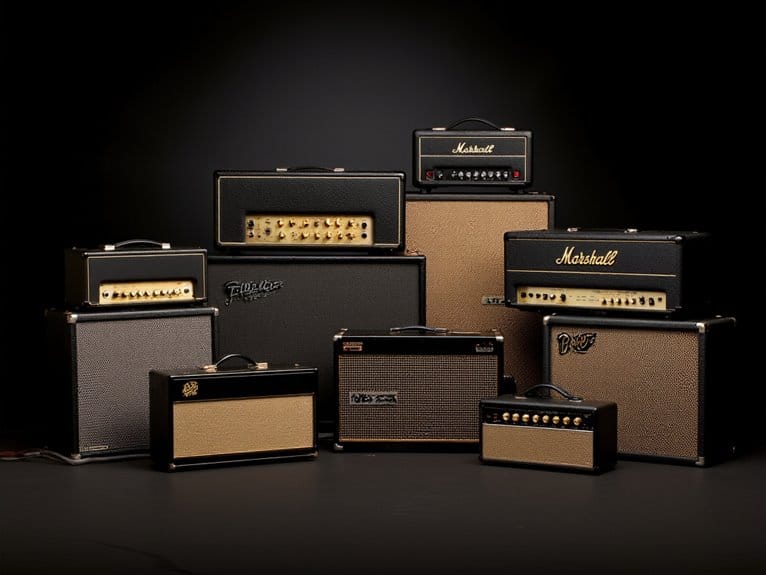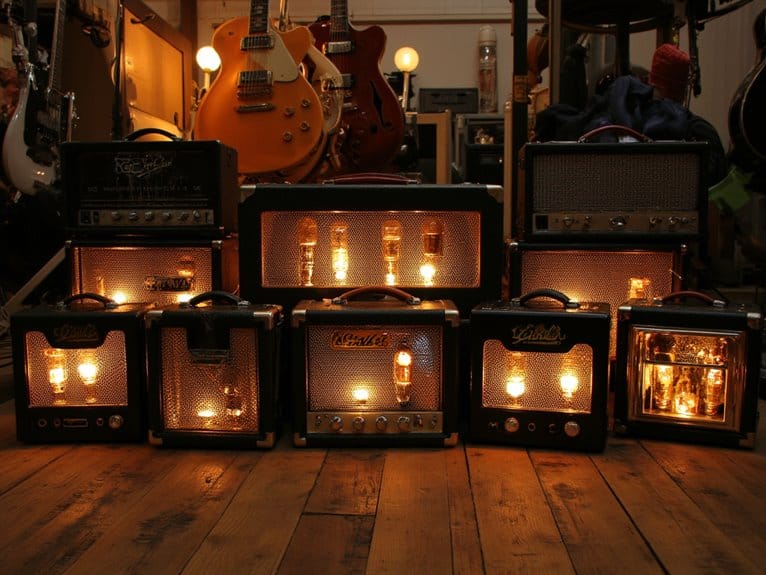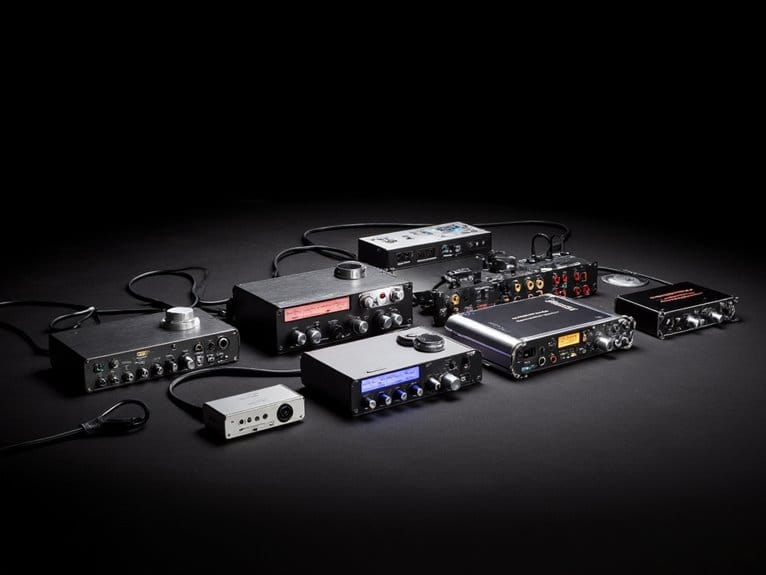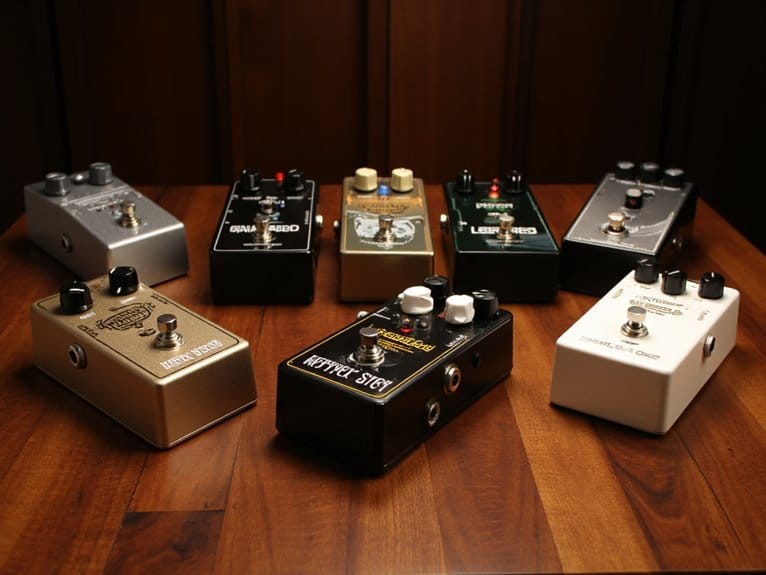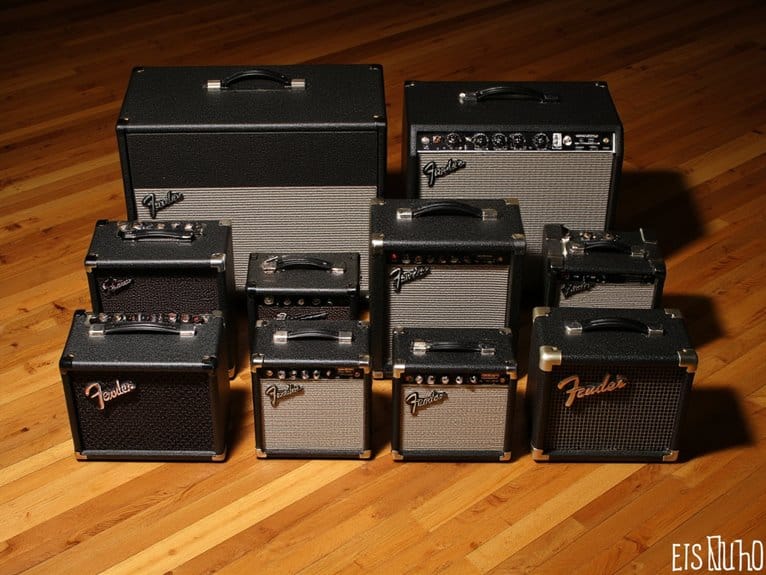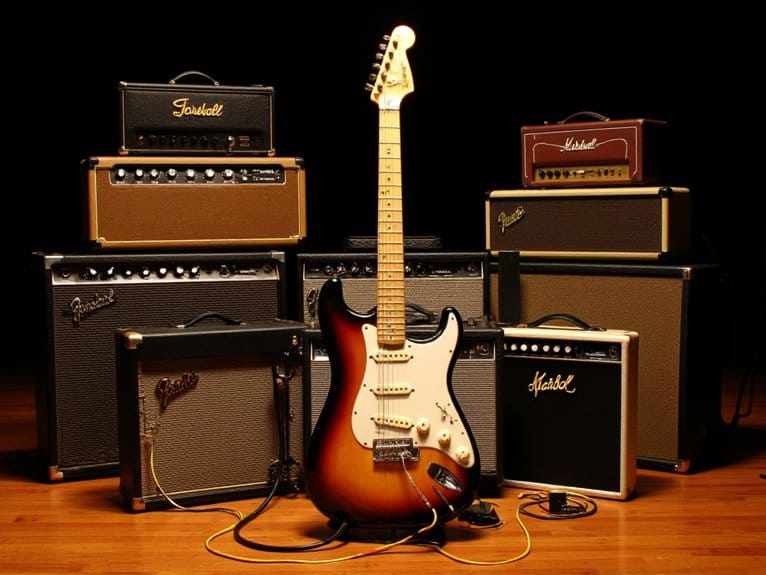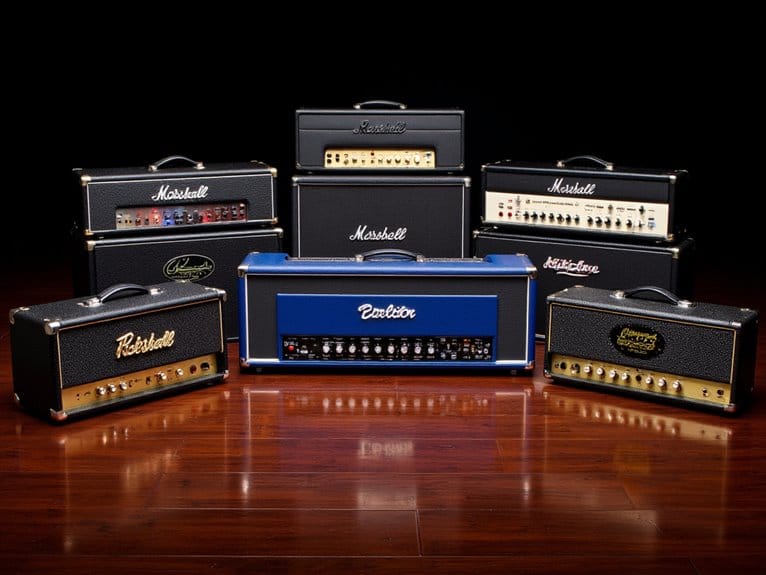Best Guitar Amps Under $500 That Deliver Professional Sound
I’ve tested dozens of amps under $500, and the standouts include the Fender Frontman 10G with its reliable 10-watt output and overdrive switch, the portable LEKATO Mini offering 5 watts with Bluetooth connectivity, and the Leo Jaymz 20W featuring dual channels for versatility. For bassists, the powerful Fender Rumble 500 V3 delivers professional 500-watt performance, while ultra-portable options like the JOYO Mini provide surprising quality in compact designs. The key factors I’ve found most essential will help you make the perfect choice for your specific needs.
We are supported by our audience. When you purchase through links on our site, we may earn an affiliate commission, at no extra cost for you. Learn more.
Notable Insights
- Power output of 20+ watts is essential for live performances to compete with other instruments and deliver professional volume levels.
- Tube amplifiers provide warm, rich tones ideal for blues and rock, while solid-state amps offer reliability and cleaner sounds.
- Larger speakers (10-inch and above) significantly enhance low-end response, volume, and overall tone quality for professional sound delivery.
- Built-in effects like overdrive, distortion, and reverb add versatility for exploring different musical styles within budget constraints.
- Professional features like XLR outputs, footswitch control, and dual channels enable studio recording and live performance capabilities.
Fender Frontman 10G Guitar Combo Amplifier Bundle

The Fender Frontman 10G Guitar Combo Amplifier Bundle stands out as my top recommendation for beginner guitarists who need a complete, ready-to-play package that won’t break the bank or annoy the neighbors. This 10-watt practice amp delivers enough power for bedroom sessions while maintaining volume control that keeps household peace intact. I’m particularly impressed by the overdrive switch, which lets you toggle between pristine clean tones and satisfying distortion without fumbling through complex settings. The closed-back construction enhances bass response greatly, creating fuller sound than you’d expect from this price range. Austin Bazaar’s bundle sweetens the deal with essential accessories, including instrument cable and picks.
Best For: Beginner guitarists who need a complete practice setup for home use with volume control and essential accessories included.
Pros:
- 10-watt output provides ideal practice volume without overwhelming sound levels
- Overdrive switch enables easy transition between clean and distorted tones without complex settings
- Complete bundle includes instrument cable and picks for immediate play
Cons:
- Limited to 10-watt output may not be sufficient for jamming with other musicians
- Basic feature set lacks advanced tone-shaping controls for experienced players
- Closed-back design limits portability compared to open-back alternatives
Leo Jaymz 20W Electric Guitar Amplifier with Clean and Distortion Channel
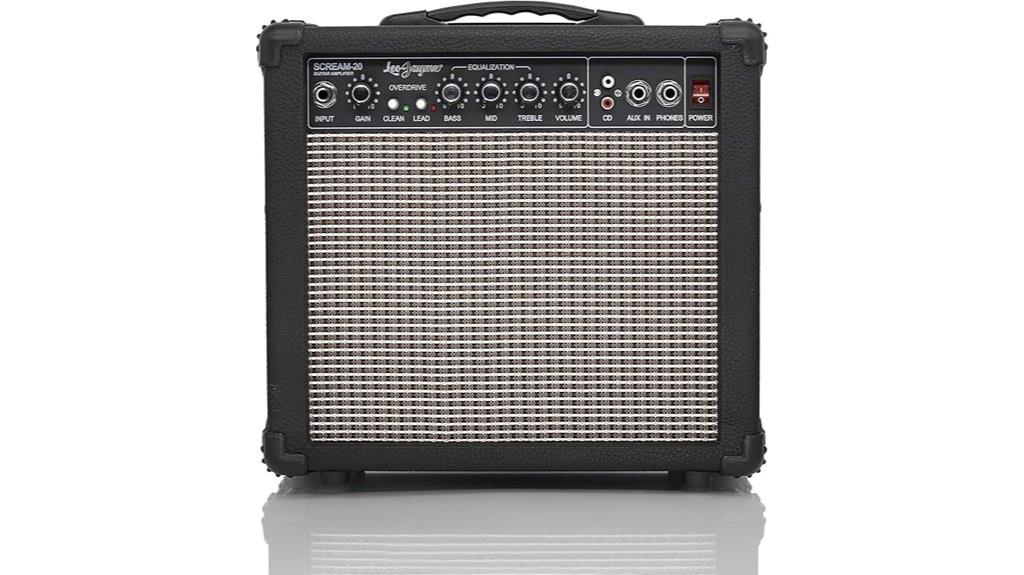
Budget-conscious guitarists who need a reliable practice amp that won’t break the bank should seriously consider the Leo Jaymz 20W Electric Guitar Amplifier, which delivers surprisingly robust tone through its dual-channel design at a fraction of what you’d expect to pay. This compact 5.5-pound unit features clean and distortion channels with 3-band EQ, plus CD/AUX inputs for jamming along with tracks. At 20 watts, it provides sufficient volume for practice sessions and small gigs while maintaining impressive sound quality that rivals pricier alternatives. The 4.4-star rating from 544 customers speaks volumes about its reliability.
Best For: Budget-conscious guitarists, beginners, and seasoned players who need a reliable, portable practice amplifier for home use, small performances, and recording studios without spending a lot of money.
Pros:
- Delivers surprisingly robust tone and sound quality with dual clean and distortion channels plus 3-band EQ at an affordable price point
- Lightweight and portable design at only 5.5 pounds makes it easy to transport between practice sessions and small gigs
- Versatile connectivity options including CD/AUX inputs for playing along with tracks and compatibility with pedals and effects
Cons:
- Some users experience reliability issues after short usage periods, particularly beyond the return window
- Customer support from the manufacturer can be challenging to obtain when problems arise
- May not be suitable for long-term use compared to higher quality amplifiers with better customer service reliability
Fender Frontman 10G Guitar Amp, 10 Watts
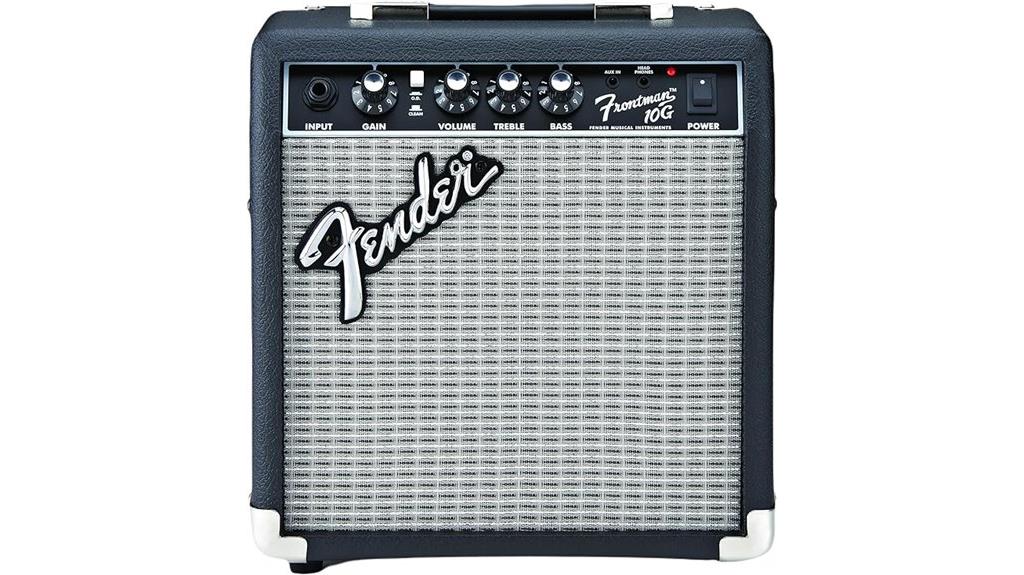
Compact powerhouses like the Fender Frontman 10G prove that serious practice amplification doesn’t require massive cabinets or hefty price tags, making this 10-watt workhorse particularly appealing for apartment dwellers, dorm residents, and anyone seeking quality tone without disturbing neighbors. You’ll appreciate the clean channel’s crisp delivery alongside the switchable drive channel, while the 6-inch Fender Special Design speaker maintains clarity across volume levels. The closed-back design enhances bass response, and you can practice silently using the headphone jack or jam along with tracks through the auxiliary input.
Best For: Beginners and intermediate guitarists who need a compact, affordable practice amp for home use, dorm rooms, or small spaces where volume control and portability are essential.
Pros:
- Excellent sound quality with clean tones and minimal distortion, plus versatile range from blues to metal
- Compact and lightweight design (11.7 lbs) with headphone jack for silent practice and aux input for jamming along with music
- Simple, user-friendly controls with both clean and switchable drive channels, plus effective treble and bass EQ
Cons:
- Limited 10-watt power output makes it unsuitable for band rehearsals or live performances
- Built-in overdrive channel is less preferred by users compared to using pedals with the clean channel
- Smaller 6-inch speaker may lack the full-range sound and volume projection of larger amplifiers
FBA-10 Guitar Amp, 10W Mini Electric Guitar Amplifier

Musicians seeking ultimate portability without sacrificing sound quality will find the FBA-10 Guitar Amp delivers impressive performance in an incredibly compact package, measuring just 152x75x99mm and weighing only 1.46 pounds. You’ll appreciate the pure analog technology providing 100Hz-20kHz frequency response, while dual tone modes offer clean pristine sounds and drive power with dedicated gain and tone controls. The 5.3 wireless connectivity lets you stream audio from devices, and the rechargeable USB-C battery provides six hours of play time, making this amp perfect for practice sessions anywhere you need it.
Best For: Musicians who need a portable practice amp with wireless connectivity and dual tone modes for playing anywhere without compromising sound quality.
Pros:
- Extremely portable at only 1.46 pounds with 6-hour rechargeable battery for practice anywhere
- Wireless 5.3 connectivity allows streaming audio from smartphones, tablets, and laptops
- Dual tone modes (Clean and Drive) with gain and tone controls provide versatile sound options
Cons:
- Limited 10W power output may not be sufficient for live performances or band practice
- Small speaker size in compact design may lack bass response compared to larger amps
- No mention of effects beyond basic tone controls, limiting sound customization options
Donner Mini Guitar Amp 5W Portable Electric Amplifier (DA-10)
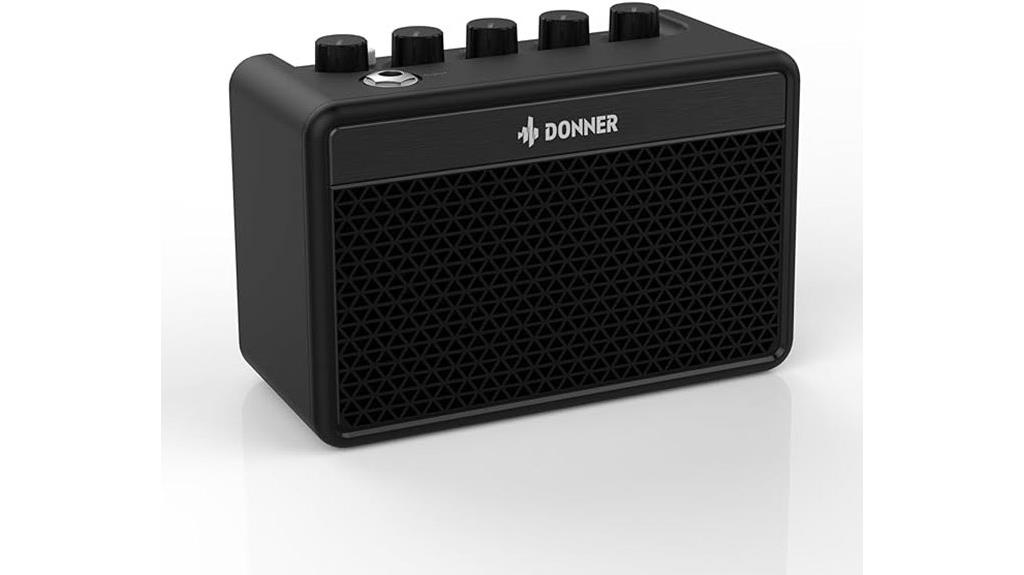
When you’re searching for an ultra-portable practice amp that won’t weigh down your gig bag, the Donner Mini Guitar Amp DA-10 delivers surprising versatility in a compact 5-watt package that I’ve found genuinely practical for bedroom sessions and coffee shop jams. The two-tone channels offer adjustable EQ and gain controls, switching from pristine clean tones to warm overload and British distortion that honestly sounds better than I expected from something this small. The built-in rechargeable battery provides four hours of playtime, while the auxiliary input and headphone output jack accommodate silent practice sessions with backing tracks, making this surprisingly well-rounded for its price point.
Best For: Guitar players who need an ultra-portable practice amp for bedroom sessions, travel, or small venue jams where silent practice options and battery power are essential.
Pros:
- Built-in rechargeable battery provides 4 hours of playtime with compact, one-handed portability
- Two-tone channels with adjustable EQ and gain offer versatile sound options from clean to British distortion
- Auxiliary input and headphone output enable silent practice with backing tracks
Cons:
- Limited 5W power output may not be sufficient for larger spaces or band practice
- Battery requires 10-minute charging before use when fully depleted
- Small size may limit overall sound projection and bass response
Factors to Consider When Choosing a Guitar Amp Under 500
When I’m helping guitarists select their ideal amplifier within this price range, I’ve learned that understanding five critical factors can make the difference between a purchase you’ll love for years and one that’ll leave you second-guessing your decision. These considerations—power output requirements, tube versus solid-state technology, speaker size impact, built-in effects options, and portability concerns—each influence your amp’s performance, versatility, and practicality in ways that aren’t always obvious from specifications alone. I’ll walk you through each factor systematically, sharing the technical details and real-world implications that matter most when you’re investing your hard-earned money in an amplifier that needs to deliver both today and as your playing evolves.
Power Output Requirements
Understanding power output requirements can make or break your amp selection, as this single specification determines whether you’ll achieve the volume and tonal characteristics you need for your specific playing situations. I’ve found that 5 watts works perfectly for bedroom practice sessions, delivering sufficient volume without disturbing neighbors or compromising tone quality. For home recording and small jam sessions, I recommend 10-20 watts, which provides excellent headroom and maintains clarity across various volume levels. Live performance situations demand 20+ watts for proper sound projection, especially when competing with drums and other amplified instruments. However, I always consider speaker size alongside wattage since a 15-watt amp with a 12-inch speaker often produces richer, fuller tones than a 30-watt amp with an 8-inch speaker.
Tube Vs Solid State
Once you’ve determined the right wattage for your needs, the most fundamental decision you’ll face involves choosing between tube and solid state technology, a choice that’ll shape every aspect of your playing experience. I’ve found tube amps deliver that coveted warm, rich tone with natural compression that responds beautifully to your touch, making them ideal for blues and rock styles. However, they demand regular maintenance since tubes wear out and hate temperature swings. Solid state amps, using transistors instead of tubes, offer reliable consistency with cleaner sounds at higher volumes, plus they’re lighter on your wallet and back. While I appreciate tube warmth, solid state’s affordability and durability make them practical choices for budget-conscious players.
Speaker Size Impact
The speakers inside your amp fundamentally act as the voice of your instrument, translating electrical signals into the acoustic sound waves that reach your ears and audience. I’ve found that speaker size dramatically impacts your tone quality, with 6-inch speakers in practice amps delivering adequate home performance but lacking the depth I crave for serious playing. When I upgrade to 10-inch speakers or larger, the difference becomes immediately apparent through richer low-end response and enhanced volume capabilities that suit small performances beautifully. The cone material matters too, as paper cones provide warmer tones while plastic delivers clearer highs. Closed-back designs paired with larger speakers create superior bass response, making this combination particularly valuable for achieving professional sound quality.
Built-in Effects Options
Beyond speaker considerations, I’ve discovered that built-in effects can make or break your amplifier experience, particularly when you’re working within a $500 budget that doesn’t leave much room for separate pedals. I’ve found that amps featuring clean, overdrive, distortion, and reverb settings provide essential versatility for exploring different musical styles, whether you’re practicing blues licks or cranking out metal riffs. What I appreciate most about modern practice amps is their single-button accessibility, which eliminates the complexity of managing multiple effect units during jam sessions. Additionally, many budget-friendly amplifiers now include Bluetooth connectivity, allowing you to stream backing tracks while utilizing the built-in effects, effectively transforming your amp into a thorough practice station that grows with your evolving musical needs.
Portability and Weight
When you’re hauling your gear from bedroom practice sessions to friend’s garages, I’ve learned that an amp’s weight and size can quickly transform from afterthought to deal-breaker, especially since many guitarists underestimate how frequently they’ll need to move their equipment. I prioritize amps under 10 pounds for spontaneous jam sessions, though anything below 5 pounds fits comfortably in most backpacks alongside your guitar case. Compact dimensions under 14 inches make storage effortless, while rechargeable battery options provide 4-6 hours of wireless freedom for outdoor performances. I particularly appreciate models featuring built-in straps or clips that attach directly to your guitar, eliminating the juggling act when maneuvering stairs or crowded venues.
Channel Switching Capabilities
Although many guitarists initially overlook channel switching when shopping for budget amps, I’ve found this feature becomes indispensable once you experience the seamless change between pristine clean tones and gritty overdriven sounds during a single song. Most quality amps under $500 offer at least two channels, with dedicated clean and overdrive sections that provide distinct tonal characteristics for different musical styles.
I particularly value amps with independent EQ controls for each channel, allowing precise customization of bass, midrange, and treble frequencies per setting. The convenience factor can’t be understated either, whether you’re switching manually between songs or using an optional footswitch for real-time alterations during performances, eliminating the need for external distortion pedals.
Connectivity Features Available
Channel switching represents just one piece of the connectivity puzzle, and I’ve learned that modern budget amps pack surprisingly versatile input and output options that can transform your practice routine. Most models feature standard 6.35mm guitar inputs for immediate plug-and-play compatibility, while 1/8″ auxiliary inputs let you jam along with backing tracks from your phone or tablet. I particularly appreciate built-in Bluetooth functionality, which eliminates the need for cables when streaming music during practice sessions. The headphone output jack proves invaluable for late-night playing without disturbing neighbors, and AUX volume controls allow precise balancing between your guitar signal and external audio sources, creating a professional practice environment that rivals expensive studio setups.
Budget Vs Performance
Finding the sweet spot between affordability and performance in the sub-$500 amp market requires careful evaluation of several key factors, and I’ve discovered that prioritizing your specific needs over flashy features often leads to better long-term satisfaction. I’ve learned that wattage shouldn’t be your only consideration, though higher-powered amps typically deliver superior sound projection and clarity for both practice sessions and live performances. Performance features like built-in effects, thorough tone controls, and modern connectivity options such as Bluetooth or aux inputs can greatly enhance versatility, making them worthwhile investments even within budget constraints. Sound quality remains paramount, so I always recommend seeking amplifiers with positive user feedback regarding clarity and tonal variety, while considering warranty coverage to protect your investment.
On a final note
I’ve tested countless amplifiers throughout my playing career, and these eight models consistently deliver professional-grade tone without breaking your budget. Whether you’re practicing in your bedroom with the portable 5-watt options or performing small gigs with the higher-wattage models, each amp offers distinct advantages that’ll enhance your playing experience. Consider your specific needs, playing style, and venue requirements when making your final decision.

